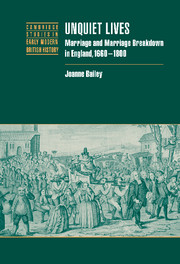Book contents
- Frontmatter
- Contents
- Acknowledgements
- List of abbreviations and conventions
- 1 Introduction: reassessing marriage
- 2 ‘To have and to hold’: analysing married life
- 3 ‘For better, for worse’: resolving marital difficulties
- 4 ‘An honourable estate’: marital roles in the household
- 5 ‘With all my worldly goods I thee endow’: spouses' contributions and possessions within marriage
- 6 ‘Wilt thou obey him, and serve him’: the marital power balance
- 7 ‘Forsaking all other’: marital chastity
- 8 ‘Till death us do part’: life after a failed marriage
- 9 ‘Mutual society, help and comfort’: conclusion
- Appendices
- Bibliography
- Index
- Titles in the series
5 - ‘With all my worldly goods I thee endow’: spouses' contributions and possessions within marriage
Published online by Cambridge University Press: 27 July 2009
- Frontmatter
- Contents
- Acknowledgements
- List of abbreviations and conventions
- 1 Introduction: reassessing marriage
- 2 ‘To have and to hold’: analysing married life
- 3 ‘For better, for worse’: resolving marital difficulties
- 4 ‘An honourable estate’: marital roles in the household
- 5 ‘With all my worldly goods I thee endow’: spouses' contributions and possessions within marriage
- 6 ‘Wilt thou obey him, and serve him’: the marital power balance
- 7 ‘Forsaking all other’: marital chastity
- 8 ‘Till death us do part’: life after a failed marriage
- 9 ‘Mutual society, help and comfort’: conclusion
- Appendices
- Bibliography
- Index
- Titles in the series
Summary
MATERIAL CONTRIBUTIONS TO MARRIAGE
Women made their first major material contribution when they entered marriage. All women except the vagrant poor brought a portion to their union. The portion, which was also commonly referred to as a fortune, varied in size from a tiny accumulation of ready cash or household goods to thousands of pounds in bonds, securities and mortgages and many acres of land. Details about wives' portions were given in fifty instances of marital difficulties. Most of the detailed descriptions of portions were contained in church court separation suits, where the type of personal or real property was briefly outlined and given a value and/or its annual income was estimated. Nearly two-thirds of the fifty couples fall within the wealthiest social groups in this book and include its few gentry and titled married folk. Still, the portions of women lower down the social scale can be glimpsed, usually through the quarter sessions records. Ann Tomlinson married a Northumberland weaver in the early eighteenth century. A widow, she brought thirteen head of beasts, household goods to the value of £20 and £3 10s per annum dower.
The values of portions can be broadly correlated with social status. Amy Erickson analysed the value of early modern portions and found that women from the upper gentry and the lowest order of the titled aristocracy had portions between £1,000 and £5,000; those from the county gentry £100 to £1,000; those from the ranks of clergymen, merchants and wealthy yeomen and tradesmen £100 to £500; from prosperous yeomen, tradesmen and craftsmen £50 to £100; and husbandmen's daughters had between £10 and £15 and labourers' daughters £1 to £5.
- Type
- Chapter
- Information
- Unquiet LivesMarriage and Marriage Breakdown in England, 1660–1800, pp. 85 - 109Publisher: Cambridge University PressPrint publication year: 2003



